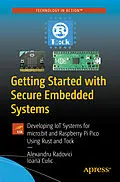Build secure and reliable IoT applications for micro:bit and Raspberry Pi Pico by using Rust and Tock.
One of the first Operating Systems written in Rust, Tock is designed to safely run multiple applications on low power devices, enabling you to build a secure foundation for IoT systems. It is an open-source OS that has recently gained popularity as companies such as Google[1] explore and integrate it into their products.
This book guides you through the steps necessary to customize and integrate Tock into your devices. First, you'll explore the characteristics of Tock and how to run it on two of the most popular IoT platforms: micro:bit and Raspberry Pi Pico. You'll also take a look at Rust and how to use it for building secure applications with Tock.
The book focuses on the Tock kernel internals and presents the steps necessary to integrate new features. From simple drivers to the more complex asynchronous ones, you are provided with a detailed description of the Tock kernel API.
Next, you'll review the Tock applications framework for C. Starting from simple Tock APIs to the more complex Inter-Process Communication system, this book provides a complete overview of the Tock application ecosystem.
By taking a practical approach, Getting Started with Secure Embedded Systems provides a starting point for building a secure IoT foundation using the Tock Operating System.
You will:
Autorentext
Alexandru Radovici has a PhD in the field of mobile computing and works as an Assistant Professor at the Politehnica University of Bucharest, teaching subjects related to operating systems, compilers and Internet of Things. Alexandru believes in the power of education and teaching is his passion, so 14 years ago he founded an NGO that focuses on organizing IT educational events. Alexandru is also the co-founder and CTO of Wyliodrin, being in touch with the latest IoT technologies. Alexandru has been a contributor to Tock, adding boards such as the STM32 Discovery Kit and adding support for screens and touch screens.
Ioana Culic is currently a PhD candidate in the field of Internet of Things and the co-founder of Wyliodrin, a company that offers educational and industrial IoT solutions. She is a Teaching Assistant at the Politehnica University of Bucharest and has also been teaching IoT technologies to high-school and university students at different events for the last five years. Despite the technical background, writing has always been Ioana's passion and she managed to mix the two. She has published several articles in magazines such as the MagPi and Make Magazine and books on Internet of Things technologies. Ioana has been porting JavaScript to Tock.
Inhalt
Chapter 1: Introduction to Embedded Operating Systems
FreeRTOS
RIOT OS
Zephyr
Mbed OS
Why is TockOS new and different?
Chapter 2: Modern Low Power Microcontrollers
Main functional components of modern microcontrollersProcessing unit
o ARM Cortex-M
o RISC-V IMC and IMAC
General memory layout
Persistent storage
Communications busses
Debug
Chapter 3: The TockOS System Architecture
Architecture
Memory Layout
KernelHardware Abstraction Layer
Capsules
Applications
Flashing the system
Examples
Chapter 4: Running TockOS
Preparing the toolsUnderstanding the kernel's source code
Compiling the kernel
Understanding the user land application source code
Compiling an application
Running using an emulator (RISC-V)
Running using a real device (STM32F412)
Chapter 5: Writing Applications
TockOS System calls
The TockOS API library
Adding a third-party library
Building for several architectures
TockOS Application Distribution
Chapter 6: Rust for TockOS
Introduction to Rust
Lifetimes
Mutable references
Chapter 7: Writing a capsule
Capsule architectureAsynchronous API
The Hardware Interface Layer
Using a timer (for delays)
System calls implementation
Writing a component
Using ...
